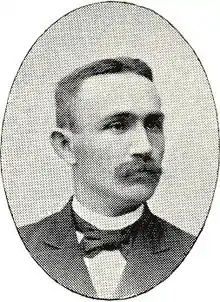Anders Wiman
Anders Wiman (11 February 1865 – 13 August 1959) was a Swedish mathematician. He is known for his work in algebraic geometry and applications of group theory.
Anders Wiman | |
|---|---|
 | |
| Born | 11 February 1865 Hammarlöv, Malmöhus County |
| Died | 13 August 1959 (aged 94) |
| Nationality | Swedish |
| Alma mater | Lund University |
| Scientific career | |
| Fields | Mathematics |
| Institutions | Uppsala University |
| Doctoral advisor | Carl Fabian Björling |
| Doctoral students | Arne Beurling Fritz Carlson |
Life
Wiman was born to well-off land-owing farmer family in Hammarlöv, Sweden in 1865. He attended school in Lund, and graduated from secondary school in 1885. In the autumn of the same year, Wiman went to Lund University studying Mathematics, Botany and Latin. He attained Bachelor's degree in 1887 and his Licentiate in 1891.[1] He continued his study in the same university under supervision of Carl Fabian Björling and was awarded doctorate in 1892, with thesis Klassifikation af regelytorna af sjette graden (Classification of regular surfaces of degree 6).
In 1892, Wiman was appointed as a docent (equivalent of assistant professor) in Lund University. There, his work on the classification of finite geometrical groups in the last few years of the 19th century was seen impressive. He classified all algebraic curves of genus 3, 4, 5 and 6 which have non-trivial algebraic automorphisms. In a paper for approximations to small denominators in 1900, Wiman applied measure theory to the probabilistic problem, and became the first person to do so.
In 1901, Wiman accepted an extraordinary professorship in algebra and number theory at Uppsala University. Topics he studied here included solubility of algebraic equations, Galois group of soluble equations of prime degree, and entire functions. Wiman was promoted to an ordinary professor in 1906, and held the chair at Uppsala until 1929. In that year, Wiman was made professor emeritus, but he remained active in teaching.[1]
In 1904 Wiman was an Invited Speaker of the ICM in Heidelberg.[2] Wiman was from 1908 an editor of Acta Mathematica.
Wiman returned to Lund in his final year, and stayed there until he died.[1]
Awards and honours
Membership of the Royal Physiographic Society in Lund (1900);
Membership of the Royal Society of Sciences in Uppsala (1905);
Membership of Royal Swedish Academy of Sciences (1905);
Membership of the Royal Society of Arts and Sciences in Gothenburg (1920);
Honorary membership of the Royal Society of Sciences in Uppsala (1938).[1]
Work
The main focus of Wiman's research was algebraic geometry and applications of group theory to geometry and function theory. He proved that for n > 7, in less than n–2 dimensions, there are no groups of collineations that are isomorphic to the symmetric or alternating group on n symbols. He also determined all finite groups of birational transformations of the plane.[3] Wiman wrote the article on finite groups of linear transformations for Klein's encyclopedia.
In function theory he did important work on entire functions. From 1914 to 1916 he introduced what is now called Wiman-Valiron theory (named after him and Georges Valiron).[1][4][5][6] Wiman's generalization of a theorem of Hadamard is known as Wiman's theorem.[7][8] Wiman's theorems for quasiregular mappings shows that an entire holomorphic function of order less than 1/2 has a minimum modulus converging to along a sequence.[9]
He also introduced Wiman's sextic curve, the Wiman inequality, and the Wiman bound.[1]
His investigations on the zeros of the derivatives of entire functions — along with similar investigations by George Pólya – had a great influence on the theory of entire functions; in particular, the now-proved Wiman conjecture,[10] [11] and the now-proved Pólya-Wiman conjecture[12] have inspired much research.
Notable PhD Students
Arne Beurling (1933) and Fritz Carlson (1914) were among his students in Uppsala University.[13]
References
- O'Connor, John J; Robertson, Edmund F. "Anders Wiman". MacTutor History of Mathematics archive. School of Mathematics and Statistics, University of St Andrews, Scotland.
- "Die metazyklischen Gleichungen 9. Grades von A. Wiman". Verhandlungen des dritten Mathematiker-Kongresses in Heidelberg von 8. bis 13. August 1904. Leipzig: B. G. Teubner. 1905. pp. 190–193.
- Anders Wiman: Zur Theorie der endlichen Gruppen von birationalen Transformationen in der Ebene (April 1896), Mathematische Annalen 48, September 1896, pp. 195–240
- Anders Wiman: Über den Zusammenhang zwischen dem Maximalbetrage einer analytischen Funktion und dem grössten Gliede der zugehörigen Taylor’schen Reihe, Acta Mathematica 37, December 1914, pp. 305–326
- Anders Wiman: Über den Zusammenhang zwischen dem Maximalbetrage einer analytischen Funktion und dem grössten Beitrage bei gegebenem Argumente der Funktion, Acta Mathematica 41, December 1916, pp. 1–28
- Hayman, W. K. (1974). The local growth of power series: a survey of the Wiman-Valiron method. Canadian Mathematical Bulletin, 17(3), 317–358.
- Anders Wiman: Sur une extension d’un théorème de M. Hadamard (7. Juni 1905), Arkiv för Matematik, Astronomi och Fysik, vol. 2, issue 14, 1905, pp. 1–5 (in French)
- Anders Wiman: Über eine Eigenschaft der ganzen Funktionen von der Höhe Null (11 February 1914), Mathematische Annalen 76, March 1915, pp. 197–211
- Martio, O.; Miklyukov, V. M.; Vuorinen, M. (December 2010). "Wiman and Arima Theorems for Quasiregular Mappings". Journal of Inequalities and Applications. 2010 (1): 1–29. doi:10.1155/2010/604217. ISSN 1029-242X.
- Terence Sheil-Small: On the zeros of the derivatives of real entire functions and Wiman’s conjecture, Annals of Mathematics (2) 129, 1989, pp. 179–193 doi:10.2307/1971490
- W. Bergweiler, A. Eremenko and J. Langley: Real entire functions of infinite order and a conjecture of Wiman, Geometric and Functional Analysis (GAFA), 13, 5 (2003), 975-991.
- Thomas Craven, George Csordas, Wayne Smith: The zeros of derivatives of entire functions and the Pólya-Wiman conjecture, Annals of Mathematics (2) 125, 1987, pp. 405–431 doi:10.2307/1971315
- "Anders Wiman - The Mathematics Genealogy Project". www.mathgenealogy.org. Retrieved 2022-06-29.
External links
- Anders Wiman at the Mathematics Genealogy Project
- (in French) Obituary by Trygve Nagell, appeared in Acta Mathematica 103 (1960)